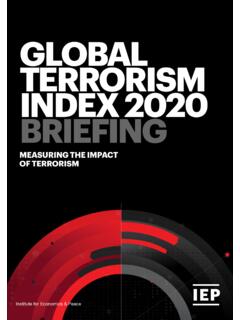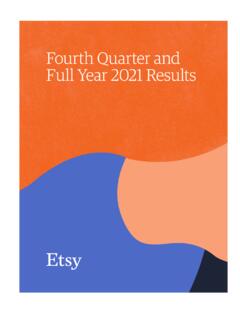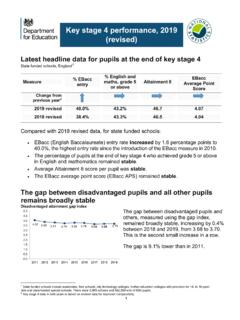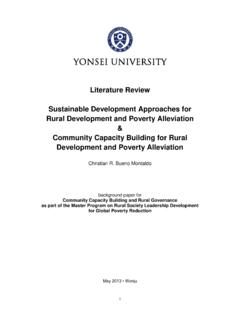Transcription of GLOBAL PEACE - Vision of Humanity
1 MEASURING PEACE IN A COMPLEX WORLDI nstitute for Economics & PeaceGLOBAL PEACE INDEX GLOBAL PEACE INDEX 20202020 Quantifying PEACE and its BenefitsThe Institute for Economics & PEACE (IEP) is an independent, non-partisan, non-profit think tank dedicated to shifting the world s focus to PEACE as a positive, achievable, and tangible measure of human well-being and achieves its goals by developing new conceptual frameworks to define peacefulness; providing metrics for measuring PEACE ; and uncovering the relationships between business, PEACE and prosperity as well as promoting a better understanding of the cultural, economic and political factors that create is headquartered in Sydney, with offices in New York, The Hague, Mexico City, Brussels and Harare.
2 It works with a wide range of partners internationally and collaborates with intergovernmental organisations on measuring and communicating the economic value of more information visit cite this report as: Institute for Economics & PEACE . GLOBAL PEACE Index 2020: Measuring PEACE in a Complex World, Sydney, June 2020. Available from: (accessed Date Month Year). GLOBAL PEACE INDEX 2020 | 1 Key Findings 4 Highlights62020 GLOBAL PEACE Index Rankings 8 Regional Overview 13 Improvements & Deteriorations 20 GPI Trends 26 GPI Domain Trends 28 Civil Unrest 32 The Economic Value of PEACE 2019 42 Methodology at a Glance 50 What is Positive PEACE ?
3 54 Positive PEACE and the COVID-19 Pandemic 57 Trends in Positive PEACE 67 Introduction72 The Types of Ecological Threat 74 Appendix A: GPI Methodology 84 Appendix B: GPI indicator sources, definitions & scoring criteria 88 Appendix C: GPI Domain Scores 96 Appendix D: Economic Cost of Violence 99 ContentsTRENDS IN PEACEFULNESS25 ECOLOGICAL THREAT REGISTER71 APPENDICES83 POSITIVE PEACE53 ECONOMIC IMPACT OF VIOLENCE41 EXECUTIVE SUMMARY2 RESULTS5 GLOBAL PEACE INDEX 2020 | 2 EXECUTIVE SUMMARYThis is the 14th edition of the GLOBAL PEACE Index (GPI), which ranks 163 independent states and territories according to their level of peacefulness.
4 Produced by the Institute for Economics and PEACE (IEP), the GPI is the world s leading measure of GLOBAL peacefulness. This report presents the most comprehensive data-driven analysis to-date on trends in PEACE , its economic value, and how to develop peaceful GPI covers per cent of the world s population, using 23 qualitative and quantitative indicators from highly respected sources, and measures the state of PEACE across three domains: the level of Societal Safety and Security; the extent of Ongoing Domestic and International Conflict; and the degree of Militarisation.
5 In addition to presenting the findings from the 2020 GPI, this year s report includes an analysis of the effect of the COVID-19 pandemic on PEACE , including Positive PEACE : the attitudes, institutions and structures that create and sustain peaceful societies. It examines how the impact of the pandemic, and in particular its economic consequences will increase the risk of severe deteriorations in Positive PEACE over the next few years, and also examines which countries are best placed to recover from the results this year show that the level of GLOBAL peacefulness deteriorated, with the average country score falling by per cent.
6 This is the ninth deterioration in peacefulness in the last twelve years, with 81 countries improving, and 80 recording deteriorations over the past year. The 2020 GPI reveals a world in which the conflicts and crises that emerged in the past decade have begun to abate, only to be replaced with a new wave of tension and uncertainty as a result of the COVID-19 remains the most peaceful country in the world, a position it has held since 2008. It is joined at the top of the index by New Zealand, Austria, Portugal, and Denmark. Afghanistan is the least peaceful country in the world for the second year in a row, followed by Syria, Iraq, South Sudan and Yemen.
7 All, except Yemen, have been ranked amongst the five least peaceful since at least two of the nine regions in the world became more peaceful over the past year. The greatest improvement occurred in the Russia and Eurasia region, followed by North America. North America was the only region to record improvements across all three domains, while Russia and Eurasia recorded improvements in Ongoing Conflict and Safety and Security, but a deterioration on the Militarisation America and Central America and the Caribbean recorded the largest and second largest deterioration on the 2020 GPI.
8 While South America s average deterioration in peacefulness was driven by deteriorations on Militarisation and Safety and Security, the fall in peacefulness in Central America and the Caribbean was driven by changes in Ongoing has declined percent since 2008 with 81 GPI countries recording a deterioration, and 79 improving. Fifteen of the 23 GPI indicators are less peaceful on average in 2020 when compared to of the three GPI domains deteriorated over the past decade, with Ongoing Conflict deteriorating by per cent and Safety and Security deteriorating by per cent.
9 Terrorism and internal conflict have been the biggest contributors to the GLOBAL deterioration in peacefulness. Ninety-seven countries recorded increased terrorist activity, while only 43 had lower levels of terrorism. However, after peaking in 2014 during the height of the Syrian civil war, total deaths from terrorism have fallen every year for the last five years. By contrast, the Militarisation domain has recorded a per cent improvement since 2008. The number of armed services personnel per 100,000 people has fallen in 113 countries, and military expenditure as a percentage of GDP fell in year s report also looks at the trends in civil unrest over the past decade.
10 It finds that there has been a sharp increase in civil unrest events since 2011, with over 96 countries experiencing at least one violent demonstration in 2019. From 2011 to 2019, the number of riots rose by 282 per cent and general strikes rose by 821 per had the largest number of protests, riots and strikes over the period, totalling nearly 1,600 events from 2011 to 2018. Sixty-five per cent of the civil unrest events in Europe were nonviolent. Civil unrest in sub-Saharan Africa rose by more than 800 per cent over the period, from 32 riots and protests in 2011 to 292 in 2018.








